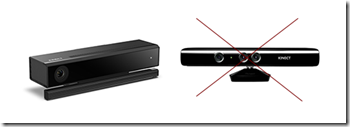Yes. That’s a bit of a confusing title, but it seems best to lay out the complexity upfront. So far there have been two generations of the Kinect sensor which combine a color camera, a depth sensing camera, an infrared emitter (basically used for the depth sensing camera) and a microphone array which works as a virtual directional shotgun microphone. Additional software called the Kinect SDK then allows you to write programs that read these data feeds as well as interpolating them into 3D animated bodies that are representations of people’s movements.
Microsoft has just announced that they will stop producing separate versions of the Kinect v2, one for windows and one for the XBox One, but will instead encourage developers to purchase the Kinect for Windows Adapter instead to plug their Kinects for XBox One into a PC. In fact, the adapter has been available since last year, but this just makes it official. All in all this is a good thing. With the promise that Universal Windows Apps will be portable to XBox, it makes much more sense if the sensors – and more importantly the firmware installed on them – are exactly the same whether you are on a PC running Windows 8/10 or an XBox running XBox OS.
This announcement also vastly simplifies the overall Kinect hardware story. Up to this point, there weren’t just two generations of Kinect hardware but also two versions of the current Kinect v2 hardware, one for the Xbox and one for Windows (for a total of four different devices). The Kinect hardware, both in 2010 and in 2013, has always been built first as a gaming device. In each case, it was then adapted to be used on Windows machines, in 2012 and 2014 respectively.
The now discontinued Kinect for Windows v2 differed from the Kinect for the Xbox One in both hardware and software. To work with Windows machines, the Kinect for Windows v2 device uses the specialized power adapter to pump additional power to the hardware (there is a splitter in the adapter that attaches the hardware to both a USB port as well as a wall plug). The Xbox One, being proprietary hardware, is able to pump enough juice to its Kinect sensor without needing special adapter. Additionally, the firmware for the original Kinect for Windows v1 sensor diverged over time from the Kinect for Xbox’s firmware – which led to differences in how the two versions of the hardware performed. It is now clear that this will not happen with Kinect v2.
Besides the four hardware devices and their respective firmware, the loose term “Kinect” can also refer to the software APIs used to incorporate Kinect functionality into a software program. Prior to this, there was a Kinect for Windows SDK 1.0 through 1.8 that was used to program against the original Kinect for Windows sensor. For the Kinect for XBox One with the Kinect for Windows Adapter, you will want to use the Kinect for Windows SDK 2.0 (“for Windows” is still part of the title for now, even though you will be using it with a Kinect for XBox One, though of course you can still use it with the Kinect for Windows v2 sensor if you happen to have bought one of those prior to their discontinuation). There are also other SDKs floating around such as OpenNI and Libfreenect.
[Much gratitude to Kinect MVP Bronwen Zande for helping me get the details correct.]
